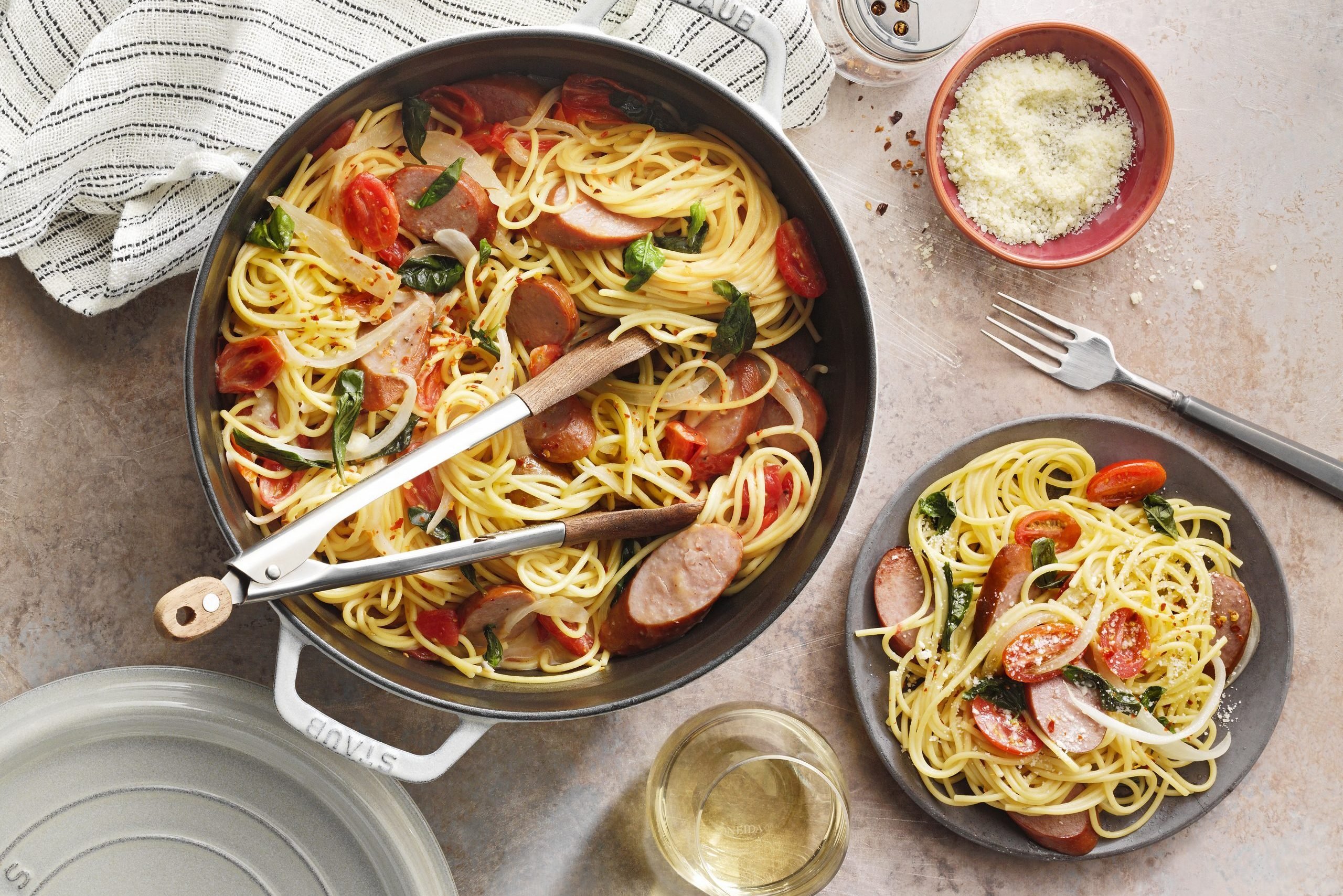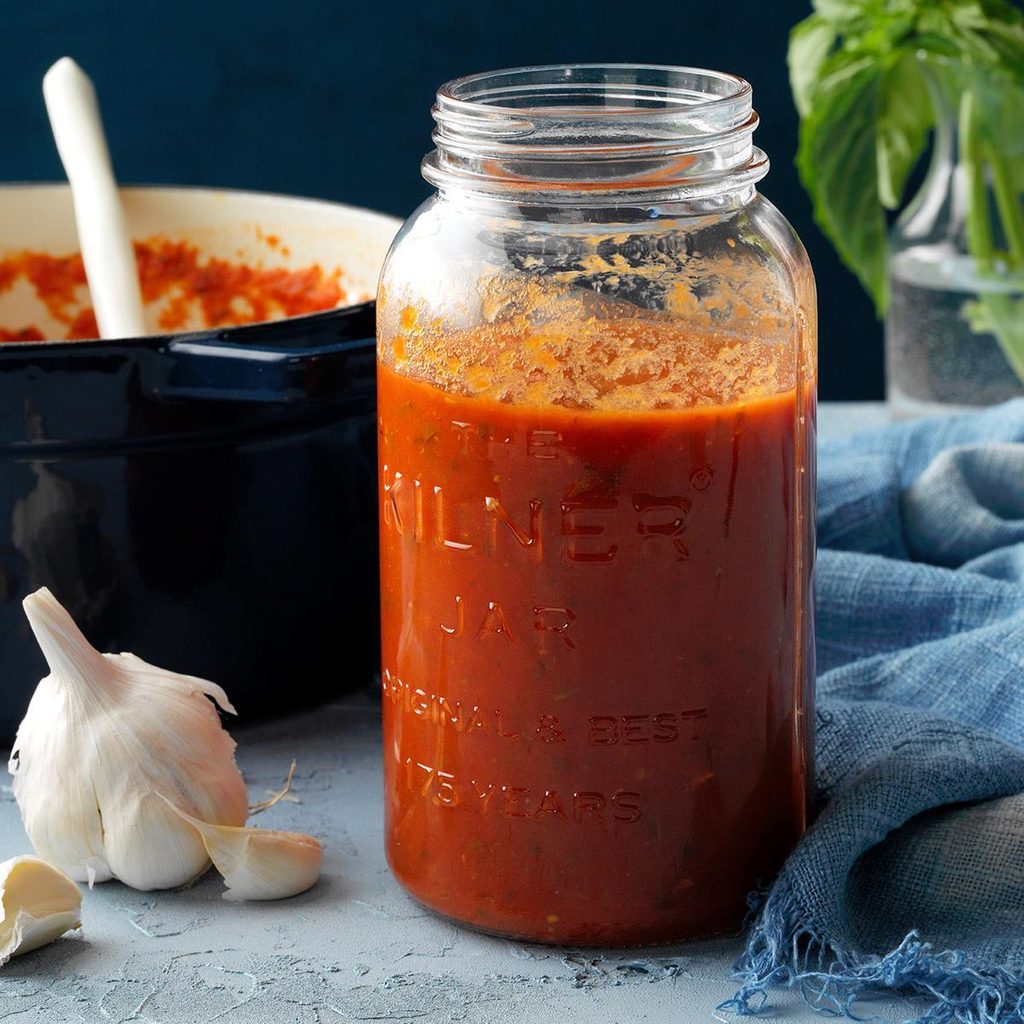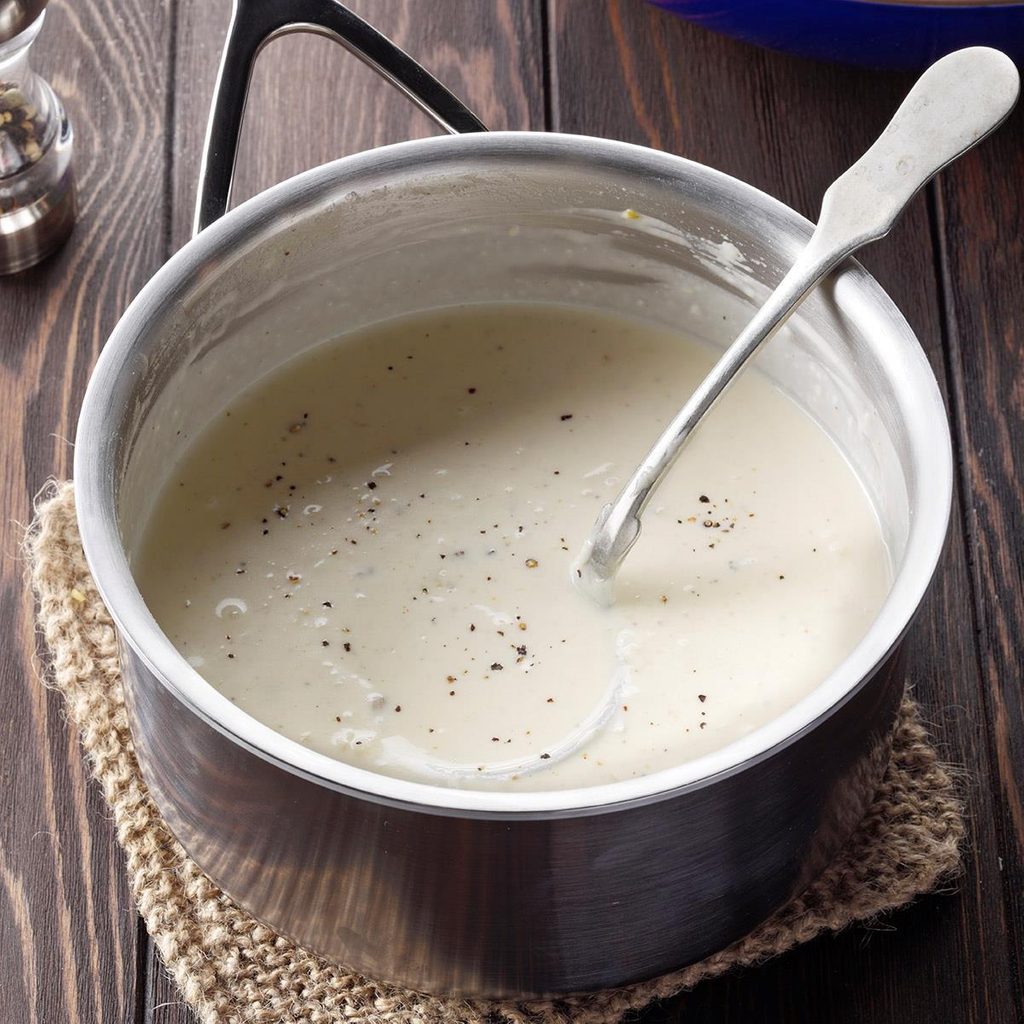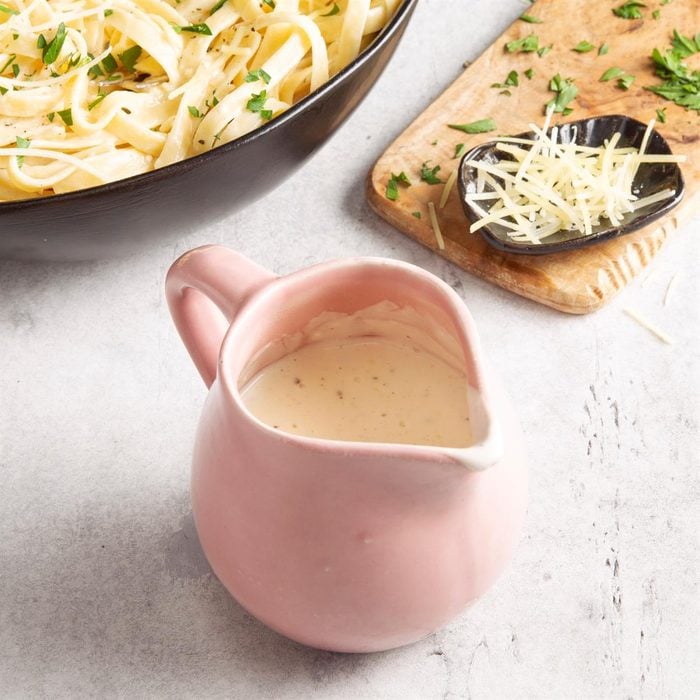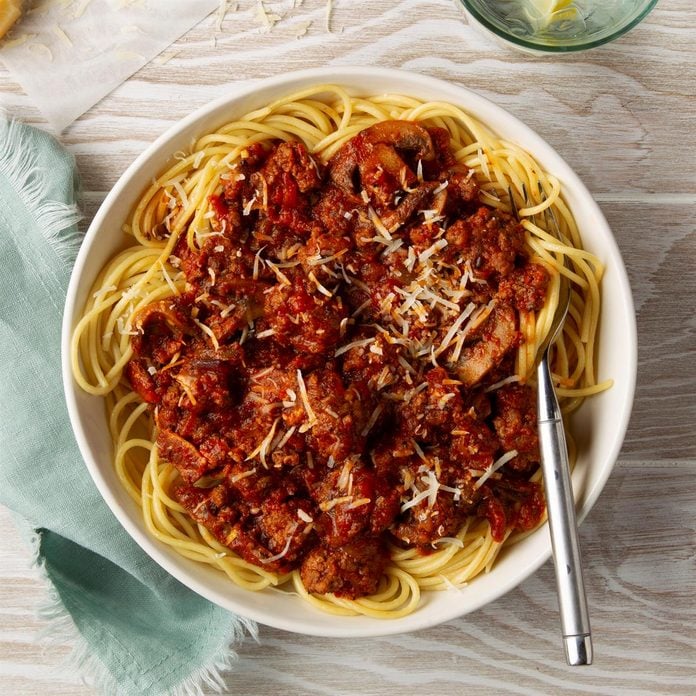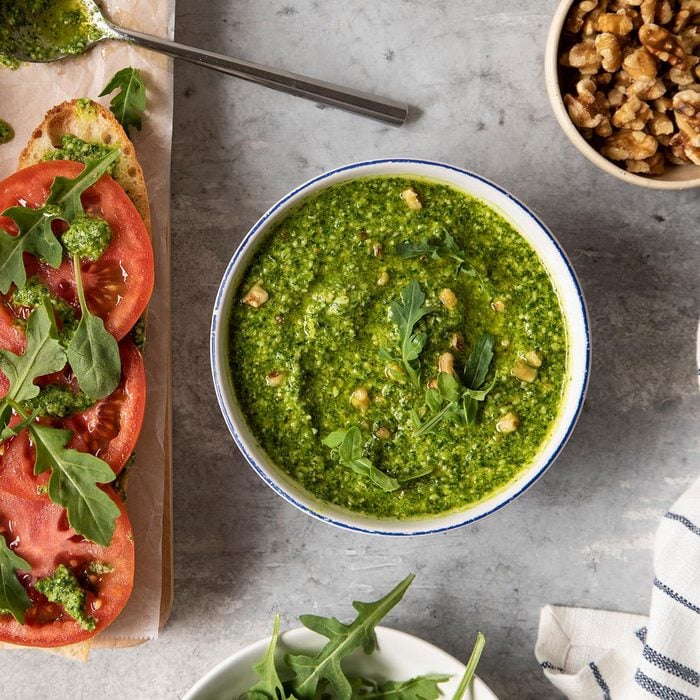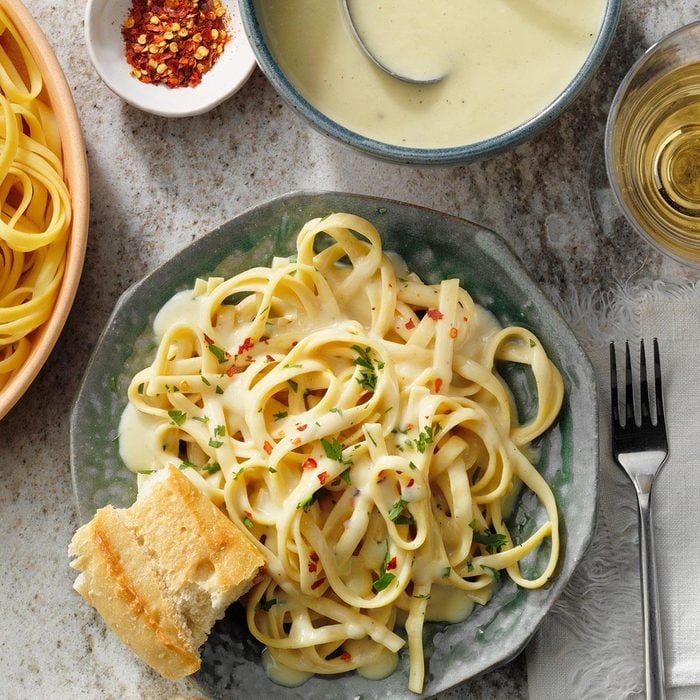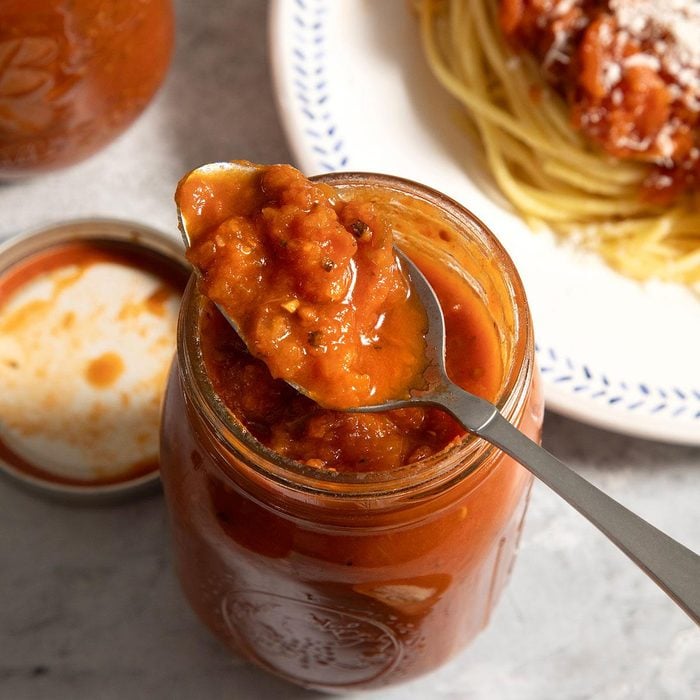I grew up eating dried pasta, so it wasn’t until much later in life that I considered the debate of fresh pasta vs. dry pasta. Specialty grocery stores weren’t really a thing in the ’80s, and my mother certainly didn’t have time to make pasta from scratch. So we stocked up on dried spaghetti, fettuccine and any tube noodle that worked for making casseroles. It wasn’t until I went to culinary school that I fell in love with homemade pasta. Its rich flavor and luscious texture lured me in, and I spent hours practicing and kneading until I could make pasta with my eyes closed.
Today, you don’t even need to put in the work to enjoy fresh pasta: It’s available in the refrigerated section at most grocery stores. But, despite my love of fresh pasta, I’ve learned it’s not necessarily better than dry pasta. Both are worthy of a restaurant-quality meal—the one you choose depends on the pasta sauce you pair it with.
What’s the Difference Between Fresh and Dry Pasta?
Fresh or dry pasta can be used in any recipe, but they have different flavors and textures that will affect the final dish. Here are the major differences between the two to help you decide which to use.
Fresh Pasta vs. Dry Pasta: Ingredients
Dry pasta is made with water, semolina (a type of flour made from durum wheat) and sometimes egg. The ingredients are mixed together to create a crumbly dough. The dough is then pressed through an extruder fitted with a die to create the desired pasta shape, forming anything from long noodles to curly macaroni or tube-shaped ziti. Once formed, the pasta is dried for several days until the moisture evaporates, creating a shelf-stable product that’s good for several years.
Fresh pasta, on the other hand, is made with eggs and flour, usually a specialty type of flour called “00” flour. It also contains water or olive oil, and sometimes extra ingredients (like pureed spinach or spices like paprika) are added to give the dough a vibrant color. The dough is kneaded and passed through a cutting machine, or it can be hand-cut for rustic-style pasta. Because fresh pasta contains perishable ingredients, it must be cooked immediately or stored in the refrigerator.
When making fresh pasta, you’ll need to cook about 2 ounces per person. With dried pasta, it’s sometimes easier to use a cup measurer per person. Here’s our chart showing how much pasta per person you should make.
Fresh Pasta vs. Dry Pasta: Texture
Dry pasta is often cooked al dente, which means “to the tooth” in Italian. That gives dry pasta a tender-firm texture that’s perfectly chewy, and it holds up well to hearty sauces. Of course, if you continue to boil dry pasta past the al dente stage, it will eventually become soft and mushy, so you can choose the desired level of texture based on your preference.
Fresh pasta doesn’t give you any options when it comes to texture. In general, it’s smoother and softer than dried pasta, and it’s not possible to cook it to the al dente stage. Because the pasta isn’t dried through to the center, these noodles cook through in a matter of minutes, creating a uniform finish inside and out. The end result is a soft, springy texture.
Fresh Pasta vs. Dry Pasta: Cooking Time
Dry pasta cooking time depends on the size and shape. Most pasta takes 10 to 12 minutes, but thin pasta like angel hair may be done in as little as 8 minutes. Refer to the cooking instructions on the box and taste the pasta about 2 minutes before the timer expires. If it’s tender enough to chew but still contains a bit of a bite, you’ve reached al dente. If it’s too firm for your liking, continue cooking it until it reaches the preferred level of doneness.
Fresh pasta cooks much, much more quickly! Depending on the pasta’s thickness, it may be done in less than 2 minutes. Watch for the noodles to begin floating to the top of the pot. To check for doneness, bite into a noodle and look for a tiny white dot in the center. If you see it, continue cooking until it disappears, testing another noodle every 20 seconds.
Wondering how to keep those noodles from sticking? Check out our tips for how to make spaghetti noodles not stick, including dusting fresh noodles with flour (speaking of, did you know flour expires?) before dropping them in the boiling water.
Fresh Pasta vs. Dry Pasta: Storage and Shelf Life
When stored in a cool, dark place like a cupboard or pantry, dry pasta doesn’t ever really expire. The drying process removes all the moisture from the pasta, preventing it from attracting bacteria that lead to mold. That said, it tastes its freshest when used within two years of purchase.
How long does fresh pasta last? Typically, fresh pasta doesn’t have a very long shelf life. Store-bought fresh pasta is usually good for two to three days, but homemade pasta only lasts for one day in the refrigerator. If you need more time, transfer the fresh pasta to the freezer, drying it in a single layer on a baking sheet for 15 minutes before transferring the pasta to freezer-safe bags. In the freezer, it will stay good for about eight months.
Fresh Pasta vs. Dry Pasta: Where to Buy
Dried pasta is available at any grocery store. We recommend looking at the ingredients on the back of the box and avoiding any pasta that includes preservatives or stabilizers. If the packaging mentions bronze dies, the pasta was made the traditional Italian way, and the edges will be rougher to help the sauce cling to the noodles.
Fresh pasta used to be a specialty item only available at select stores, but today you can find it in the refrigerated section of most grocery stores. It’s also sold online from retailers. Avoid packaging with moisture inside, which can lead to mushy or moldy pasta. You’ll want to check the best-by date, too, before hitting the checkout.
When to Use Dry Pasta
It’s best to use dry pasta with rich, hearty sauces, like a pasta puttanesca dish or a thick, meaty ragu. That’s because dry pasta can be cooked al dente, giving the pasta a chewy bite and thick texture that holds up to these hearty sauces. Dry pasta is also ideal for casseroles and soups because it can hold up to the extended cooking time.
That said, it’s absolutely fine to use fresh pasta with rich sauces. Thick-cut homemade egg noodles are a perfect pairing for a classic bolognese, and fresh linguine will hold up fine to a seafood puttanesca. On the flip side, if your recipe calls for fresh pasta, feel free to use dry pasta if you don’t have the fresh variety on hand. For these recipes, we recommend cooking the dry pasta for the amount of time listed on the box. When they’ve reached the al dente stage, add them to the pan with the sauce and simmer the noodles in the sauce for a minute or two to help them reach a similar texture to fresh pasta.
When to Use Fresh Pasta
Fresh pasta shines with delicate sauces that accentuate its eggy flavor and chewy texture. Think carbonara, cacio e pepe or pasta tossed with simple sauces like butter, marinara or pesto. Using fresh pasta with a store-bought Alfredo sauce is an excellent way to elevate the canned sauce to something that tastes like it simmered away all day.
We don’t recommend using fresh pasta in baked recipes or anything that makes leftovers. Meal prepping for the week works well with dry pasta, but fresh pasta will fall apart in the refrigerator, turning into a gummy mess when it’s reheated. It’s best to use it for tonight’s meal and plan to have something else for lunch tomorrow.
Our Best Homemade Pasta Sauce Recipes
Stamp-of-Approval Spaghetti SauceTotal Time: 8 hours, 30 minutes
Main Ingredients: Ground beef, Italian sausage, diced tomatoes, tomato paste, basil, oregano, bay leaves
Level: Beginner
With sweet Italian sausage, ground beef, eight cloves of garlic and loads of fresh herbs, this crowd-pleasing spaghetti sauce has it all. If you're never quite sure how much pasta to cook per person, we made a handy chart to help.
"My father is very opinionated, especially about food. This recipe received his almost unreachable stamp of approval. I have yet to hear a disagreement from anyone who has tried it!" —Recipe contributor Melissa Taylor, Higley, Arizona
The Best Marinara SauceTotal Time: 1 hour, 40 minutes + simmering
Main Ingredients: Onion, garlic, plum tomatoes, basil, oregano, tomato paste, lemon
Level: Advanced
Jarred pasta sauce is pretty excellent these days, but nothing beats from-scratch marinara when you're making meatballs, manicotti and many other classic Italian dishes. We like plum tomatoes for this sauce because they're meaty, have minimal seeds and aren't too acidic.
"I developed this marinara sauce recipe with a friend to make the most of a bumper crop of tomatoes. Now we like to make huge batches—we're talking 220-pounds-of- tomatoes huge—and then give jars along with a pound of pasta as gifts around the holidays. Knowing this sauce is made from the heart with the best possible ingredients makes me feel good about giving it to my family and friends." —Recipe Contributor Shannon Norris, Cudahy, Wisconsin
Homemade Alfredo SauceTotal Time: 40 minutes
Main Ingredients: Shallots, garlic, heavy cream, Asiago, Parmesan, Romano
Level: Beginner
With three types of Italian cheese and lots of heavy cream, this decadent Alfredo sauce is best served with fettuccine and bright green vegetable side dishes for contrast. For a quick, flavorful protein, look no further than the crispy chicken cutlet.
"When I found out I had celiac disease and could no longer have fettuccine Alfredo, I was determined to figure out a way to re-create it. This has now become one of my most-requested dishes. I use gluten-free multigrain pasta, but you can use any style of pasta." —Recipe contributor Jackie Charlesworth Stiff, Frederick, Colorado
Garlic Cream SauceTotal Time: 20 minutes
Main Ingredients: Butter, garlic, cream cheese, heavy cream, Parmesan
Level: Beginner
Thickened with Parmesan and a bit of cream cheese, this luscious garlic cream sauce is a deeply flavorful twist on Alfredo. If you're someone who believes there's no such thing as too much garlic, these other recipes for garlic lovers will make good use of an abundance of cloves.
"This rich, easy garlic cream sauce recipe is requested at every family occasion I attend. Don't be afraid to alter the recipe with more or less garlic to suit your taste." —Recipe contributor Joy McQuaid, Darlington, Wisconsin
Classic PestoTotal Time: 10 minutes
Main Ingredients: Basil, Parmesan, garlic, pine nuts
Level: Beginner
Made for centuries in the Liguria region of Italy, fresh basil pesto is a nutty, fragrant sauce we love to slather on just about everything, from summer sandwiches to crostini and, of course, pasta. Since fresh basil is the star of the show, make sure your leaves are plump and bright green, with no brown spots.
"This versatile pesto boasts a perfect basil flavor. Pair it with pasta and you've got a classic Italian dinner." —Recipe Contributor Iola Egle, Bella Vista, Arkansas
Hearty Ragu BologneseTotal Time: 4 hours, 5 minutes
Main Ingredients: Onion, celery, carrot, garlic, ground beef, Italian sausage, white wine, beef broth, heavy cream, tomato paste
Level: Beginner
There's nothing more satisfying than a warming bowl of meaty bolognese, and this one becomes extra decadent with heavy cream and a trio of meats. Unsure which white wine to use in the sauce? Here's our handy guide on how to cook with wine.
"My robust ragu combines ground beef, sausage and chicken. Serve it over any type of pasta, or baked or fried polenta. It's even good on its own with a slice of hot buttered garlic bread." —Recipe contributor Caroline Brody, Forest Hills, New York
Homemade Meatless Spaghetti SauceTotal Time: 3 hours, 35 minutes
Main Ingredients: Onions, tomatoes, garlic, tomato paste
Level: Beginner
Made with fresh juicy tomatoes and a touch of brown sugar, this slow-cooked pasta sauce is a smart thing to freeze, so you can have a taste of summer in the colder months. For a little extra heft, brown some ground beef or Italian sausage to add to the cooked sauce.
"When my tomatoes ripen, the first things I make are BLTs and this homemade spaghetti sauce." —Recipe contributor Sondra Bergy, Lowell, Michigan
Red Clam SauceTotal Time: 3 hours, 25 minutes
Main Ingredients: Canned clams, diced tomatoes, tomato paste
Level: Beginner
Canned clams are our pantry secret weapon, and here they add a rich, briny flavor (plus protein!) to classic red sauce. Another Italian canned clam winner? Baked clams casino—no shells required.
"This recipe tastes like an Italian restaurant specialty and cooks while you take care of other things. What a marvelous way to jazz up pasta sauce!" —Recipe contributor JoAnn Brown, Latrobe, Pennsylvania
Pasta NapolitanaTotal Time: 2 hours, 30 minutes
Main Ingredients: Bacon, ground beef, Italian sausage, pepperoni, tomato paste, marinara sauce
Level: Intermediate
Cooking with a whopping four types of meat—bacon, ground beef, Italian sausage and pepperoni—adds so many rich layers of flavor, especially after two hours on the stove. Serve with lots of Italian bread or breadsticks, because you don't want a drop of this hearty meat sauce to go to waste.
"This is the ultimate meat lovers sauce and is my copycat version of The Cheesecake Factory's pasta. Rich and hearty, with tremendous flavors, this pasta Napolitana will disappear quickly. I always make extra sauce, as it freezes very well." —Recipe contributor John Pittman, Northampton, Pennsylvania
Slow-Cooker Clam SauceTotal Time: 3 hours, 10 minutes
Main Ingredients: Butter, olive oil, mushrooms, garlic, canned clams, sherry, lemon
Level: Beginner
The juice from canned clams lends a satisfying brinness to this slow-cooked clam sauce, which gets another pop of brightness from sherry. Serve with fresh lemon, lots of parsley and grated Parmesan cheese.
"Serve this delectable clam sauce as a hot dip for holiday get-togethers. The sauce is bright and fresh with pasta, too." —Recipe contributor Frances Pietsch, Flower Mound, Texas
Slow-Cooker Short Rib Ragu over PappardelleTotal Time: 7 hours, 30 minutes
Main Ingredients: Beef short ribs, mushrooms, onion, carrots, tomato paste, red wine, garlic, diced tomatoes, pappardelle, Parmesan
Level: Intermediate
Mushrooms add the perfect umami-boost to these succulent short ribs, which are best served over wide, flat pappardelle noodles or fettuccine. Go all in on richness and top each plate of ragu with a small, creamy scoop of burrata.
"An irresistible sauce gives the beef in this short rib ragu another dimension of flavor. Nearly any starchy side, such as potatoes or polenta, will work in place of the pasta. Short ribs are my crowd-pleaser weekend meal for all occasions." —Recipe Contributor Missy Raho, Morristown, New Jersey
Gluten-Free BechamelTotal Time: 10 minutes
Main Ingredients: Butter, gluten-free flour, 2% milk, white pepper
Level: Beginner
Given that flour is the thickening agent used in bechamel sauce, you might think that making a gluten-free version is impossible. Not so! We've found that gluten-free flour (with xanthan gum) makes a great foundation for a decadent sauce that's perfect in dishes like vegetable lasagna that swaps noodles for eggplant.
"Making a classic bechamel sauce gluten free is as simple as substituting gluten-free flour. Just make sure the flour contains xanthan gum." —Taste Recipes Test Kitchen
Arugula Walnut PestoTotal Time: 15 minutes
Main Ingredients: Arugula, Parmesan, garlic, walnuts, lemon
Level: Beginner
The secret to deliciously nutty pesto is to toast your nuts—in this case, buttery walnuts—before tossing them into the food processor. Pulverized with spicy arugula and lots of Parmesan, these greens transform into a sauce you'll want to use in everything from pasta salad to pizza.
"Arugula pesto has a nutty, bright flavor. It can be served on crostini or pizzas or tossed with pasta. For a more pronounced nutty flavor, toast the walnuts first." —Taste Recipes Test Kitchen
Spicy Fresh Tomato and Eggplant SauceTotal Time: 1 hour, 10 minutes + releasing
Main Ingredients: Eggplant, tomatoes, onion, carrot, tomato puree, Parmesan rind
Level: Beginner
You don't need meat to make a robust, hearty pasta sauce, and this tomato and eggplant sauce proves it. Tossing a Parmesan rind into the mix while cooking it adds a wonderful nutty backdrop, so make sure never to throw those beauties in the trash.
"My garden is teeming with fresh tomatoes and eggplant toward the end of summer, so I've been thinking of ways to use them. A hearty gravy for pasta is just the ticket." —Recipe contributor Teri Schloessmann, Tulsa, Oklahoma
Vegan Bechamel SauceTotal Time: 20 minutes
Main Ingredients: Vegan butter, flour, unsweetened soy milk, nutritional yeast
Level: Beginner
Yes, you can achieve a creamy, luscious bechamel sauce with no dairy at all, thanks to vegan butter-style sticks, nondairy milk alternatives and good old all-purpose flour. Nutritional yeast, also known as "nooch," adds that essential cheesy nuttiness, which is why we also love to use it in this vegan mac and cheese.
"As one of the original classic mother sauces, bechamel is a vital part of a wide variety of recipes, including casseroles, white lasagnas and mac and cheese." —Taste Recipes Test Kitchen
Italian Pasta SauceTotal Time: 2 hours, 25 minutes
Main Ingredients: Ground beef, Italian sausage, onion, celery, garlic, crushed tomatoes, tomato paste, mushrooms
Level: Intermediate
This comforting, tomato-based meat sauce makes such a delicious centerpiece for special occasions or family dinners. To lighten it up, swap in ground chicken for the beef and chicken sausage for the Italian sausage.
"When my daughter Kris got married, her new husband made something special for their wedding buffet—a big batch of this thick, flavorful pasta sauce. His grandmother brought the recipe from Italy nearly 100 years ago." —Recipe contributor Judy Braun, Juneau, Wisconsin
Zucchini Tomato PastaTotal Time: 1 hour, 20 minutes
Main Ingredients: Butter, onions, tomatoes, zucchini, garlic, pasta
Level: Beginner
Fresh summer zucchini melts into this rich tomato sauce, which is perfect atop larger pasta shapes that can stand up to its hardiness, like rigatoni, farfalle or rotini. Swap in canned tomatoes if you like, but the juicy sweetness of fresh tomatoes really makes this sauce sing.
"I came up with this recipe after planting too many zucchini plants in our vegetable garden. My husband loved it the first time I served it and now we make it quite often." —Recipe contributor Joy Turner, Amherst, Ohio
Basic Tomato SauceTotal Time: 1 hour, 10 minutes
Main Ingredients: Onion, carrots, garlic, diced tomatoes, broth, tomato paste
Level: Beginner
This classic tomato sauce recipe can be used in so many wonderful Italian dishes, from eggplant parmesan to meaty lasagna. Of course, we would also happily eat this sauce with just spaghetti, Parmesan and a glass of wine.
"This basic tomato sauce satisfies my pasta-loving husband much more than any store-bought kind. For a change of pace, I add ground beef or Italian sausage. It's also good with black olives, mushrooms and green peppers." —Recipe contributor Jennifer Stephens, Pearland, Texas
Homemade Canned Spaghetti SauceTotal Time: 2 hours, 10 minutes + simmering
Main Ingredients: Tomatoes, green peppers, onions, tomato paste, sugar, garlic, lemon, Worcestershire sauce
Level: Advanced
If you're new to canning, start with our canning 101 guide before making this rich, slightly sweet tomato sauce that shows off the deliciousness of fresh summer tomatoes. There are also a few canning supplies you should invest in, like a water bath canner and glass mason jars.
"This DIY spaghetti sauce is a tomato grower's dream come true! Use up your garden bounty and enjoy it later in the year." —Recipe contributor Tonya Branham, Moun. Olive, Alabama
Garden Harvest Spaghetti SquashTotal Time: 1 hour, 5 minutes
Main Ingredients: Spaghetti squash, red pepper, red onion, zucchini, mushrooms, leek, carrots, stewed tomatoes, tomato paste, V8 juice, spinach
Level: Intermediate
For gluten-free or low-carb eaters who hate missing out on saucy bowls of pasta, this veggie-packed tomato sauce served over spaghetti squash is a dream come true. For a quicker dinner, cook the spaghetti squash in an Instant Pot—it'll be tender, sweet and ready for sauce in under 10 minutes.
"I was in the grocery store and spotted a perfectly ripe spaghetti squash. I knew I had to try it, so I cooked it according to the label. I topped it with my favorite vegetables for pasta, and it was an instant family favorite." —Recipe contributor Veronica McCann, Columbus, Ohio
Beef Bolognese with LinguineTotal Time: 4 hours
Main Ingredients: Ground beef, onions, carrots, celery, tomato paste, garlic, red wine, diced tomatoes, beef stock, milk, Parmesan, linguine
Level: Intermediate
Like traditional bolognese sauce from Bologna, Italy, this rich meat ragu calls for a bit of milk and becomes delicately sweet with the addition of carrots. For special occasions, pair this bolognese with handmade egg pasta, which is how the sauce is traditionally served.
"After much research, tasting and tweaking, I finally came up with this beef bolognese recipe that is based on a dish from an Italian restaurant where I worked. It's perfect for feeding a house full of guests." —Recipe contributor Christine Wendland, Browns Mills, New Jersey
Spicy Pork and Butternut Squash RaguTotal Time: 5 hours, 20 minutes
Main Ingredients: Stewed tomatoes, frozen winter squash, onion, red pepper, boneless pork ribs, pasta
Level: Beginner
Tender, savory pork ribs and sweet butternut squash make the perfect pair in this hearty pasta sauce, which can also be prepared with chicken thighs. Find frozen pureed winter squash in the freezer section at the supermarket, or you can try your hand at freezing squash yourself.
"This recipe is a marvelously spicy combo that's perfect for cooler fall weather and satisfying after a day spent outdoors." —Recipe contributor Monica Osterhaus, Paducah, Kentucky
Garden Vegetable Tomato SauceTotal Time: 1 hour, 25 minutes
Main Ingredients: Zucchini, onion, mushrooms, red pepper, green pepper, garlic, crushed tomatoes, red wine
Level: Intermediate
If you like thick, hearty pasta sauces but don't always want a big bowl of ragu, this veggie-packed sauce is for you. When plump, sweet tomatoes are in season, chop them up and add into the mix with the crushed canned tomatoes, then finish with lots of fresh basil.
"I make this vegetable tomato sauce regularly and store containers of it in my freezer. It's a tasty substitute for regular pasta sauce, and the extra vegetables make it healthier. I also use it when I make pizza." —Recipe contributor Ann Sheehy, Lawrence, Massachusetts
Homemade Pasta Sauce FAQ
Why is my homemade pasta sauce so watery?
There are many reasons why your homemade pasta sauce could be watery and thin, from adding too much liquid (like stock or wine) to not cooking the sauce long enough. When in doubt, the most surefire way to thicken a pasta sauce is to cook it longer, which will slowly evaporate extra liquids
—and also help develop its flavor.
What ingredients make pasta sauce better?
Many of the best pasta sauces, like pesto and marinara, make great foundations that you can customize to your tastes with additional spices and herbs. The biggest rule of thumb for making the best-tasting pasta sauces is to use high-quality ingredients, like
San Marzano canned tomatoes, bright green basil, fresh garlic and good olive oil. For even richer flavor, cook your sauces longer, and make sure not to skimp on salt or fat. Dress up your finished sauce with the
best extra-virgin olive oil and your favorite fresh herbs.
How long does homemade pasta sauce last?
Homemade pasta sauce should last for five to seven days in the fridge. We rounded up
how to store just about every kind of food in the refrigerator if you're wondering how to store your whole meal. If you'd like to store your sauce longer than that, freeze it in airtight containers for up to three months
—just make sure it's cooled before you put it in the freezer.
